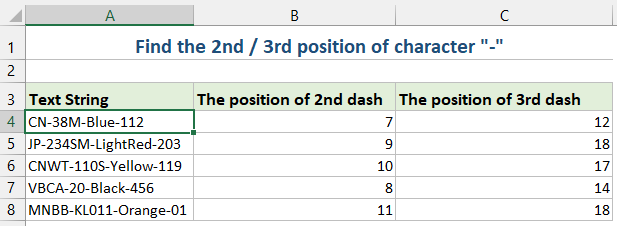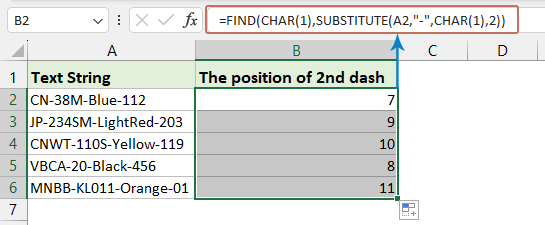Zoek de n-de keer dat een teken voorkomt in Excel – 3 snelle manieren
Het vinden van de n-de keer dat een specifiek teken voorkomt binnen een tekstreeks in Excel kan bijzonder nuttig zijn bij data-analyse, waarbij je mogelijk strings moet ontleden of informatie moet extraheren op basis van bepaalde scheidingstekens of patronen. Bijvoorbeeld, laten we de 2e of 3e keer zoeken dat het teken "-" voorkomt in een tekstreeks. Ik zal eenvoudige technieken demonstreren om deze taak efficiënt uit te voeren.

Zoek de n-de keer dat een teken voorkomt in een tekstreeks met een formule
Je kunt een formule maken om de n-de keer dat een teken voorkomt te vinden. Doe dit als volgt:
1. Voer of kopieer de volgende formule in een cel waar je het resultaat wilt krijgen:
=FIND(CHAR(1),SUBSTITUTE(A2,"-",CHAR(1),2))- "A2": De cel die de string bevat.
- "-": Het teken waar je naar zoekt.
- "2": De 2e keer dat je zoekt, je kunt dit wijzigen naar 3,4… zoals je nodig hebt.
2. Sleep vervolgens de formule naar beneden om de formule naar andere cellen te kopiëren, en de 2e positie van het teken – wordt onmiddellijk weergegeven, zie screenshot:
- "SUBSTITUTE" vervangt de n-de keer dat het teken voorkomt met een niet-afdrukbare teken (CHAR(1)).
- "FIND" zoekt naar dit niet-afdrukbare teken, wat de positie van de n-de keer dat het voorkomt oplevert.
Zoek de n-de keer dat een teken voorkomt in een tekstreeks met Kutools voor Excel
Als je geen fan bent van het gebruik van formules of VBA, kun je overwegen om een handige alternatieve optie te gebruiken – "Kutools voor Excel". Binnen de groep Formules vind je een handig hulpmiddel – "De positie van de N-de voorkomende karakter in een tekenreeks vinden", wat snel de positie van elk teken in een cel identificeert en retourneert.
Na het installeren van Kutools voor Excel, klik op "Kutools" > "Formulehulp" > "Formulehulp" om het dialoogvenster "Formulehulp" te openen. Klik op een cel waar je het resultaat wilt plaatsen. Doe vervolgens het volgende:
- Selecteer "Zoeken" uit de keuzelijst van de sectie "Formuletype";
- Kies "De positie van de N-de voorkomende karakter in een tekenreeks vinden" in de sectie "Selecteer een formule";
- Selecteer de cel die de string bevat die je gebruikt, typ vervolgens het gespecificeerde teken en de n-de keer dat het voorkomt in de tekstvakken in de sectie "Argumentinvoer";
- Klik ten slotte op de knop "OK" om het resultaat te krijgen.

Kutools voor Excel - Boost Excel met meer dan 300 essentiële tools. Geniet van permanent gratis AI-functies! Nu verkrijgen
Zoek de n-de keer dat een teken voorkomt in een tekstreeks met een door de gebruiker gedefinieerde functie
In deze sectie onderzoeken we hoe je een UDF kunt maken en gebruiken om de n-de keer dat een teken voorkomt in Excel te vinden, met een stap-voor-stap handleiding om je te helpen bij het optimaliseren van je gegevensverwerking.
- Houd de toetsen "ALT" + "F11" ingedrukt, en het venster "Microsoft Visual Basic for Applications" wordt geopend.
- Klik op "Invoegen" > "Module", en plak de volgende macro in het Modulevenster.
Function FindN(sFindWhat As String, _ sInputString As String, N As Integer) As Integer 'Updateby Extendoffice Dim J As Integer Application.Volatile FindN = 0 For J = 1 To N FindN = InStr(FindN + 1, sInputString, sFindWhat) If FindN = 0 Then Exit For Next End Function - Sluit vervolgens het vba-venster. Ga terug naar het werkblad, voer de volgende formule in een cel in, en sleep de vulgreep naar beneden om de formule naar andere cellen te kopiëren, zie screenshot:
=FindN("-",A2,3)
- Tel het aantal keren dat een woord voorkomt in een kolom
- Als je een kolom met gegevens hebt die enkele dubbele waarden bevat zoals in de onderstaande schermafbeelding te zien is, en je wilt nu het aantal keren tellen dat een specifiek woord voorkomt in deze kolom. Met deze handleiding introduceer ik enkele trucs om dit snel op te lossen in Excel.
- Vervang de eerste n tekens of de n-de keer dat een teken voorkomt door een ander teken
- In Excel gebruiken we vaak de functie Zoeken en Vervangen om een string te vinden en te vervangen, maar als je in een van de onderstaande gevallen zit, kan de functie Zoeken en Vervangen je niet helpen.
- Extraheer een n-de teken uit een string
- Over het algemeen wil je mogelijk een string extraheren na een specifiek teken, maar in dit geval wil ik het n-de teken uit een string extraheren zoals in de onderstaande schermafbeelding te zien is.
- Extraheer de eerste/laatste n tekens uit een string
- Bijvoorbeeld, er is een lijst met lange strings in elke cel, en je wilt alleen de eerste n tekens uit elke string extraheren, zoals de eerste 3 tekens van elke string, en nu kun je de volgende methoden gebruiken om dit op te lossen in Excel.
Gerelateerde artikelen:
Beste productiviteitstools voor Office
Verbeter je Excel-vaardigheden met Kutools voor Excel en ervaar ongeëvenaarde efficiëntie. Kutools voor Excel biedt meer dan300 geavanceerde functies om je productiviteit te verhogen en tijd te besparen. Klik hier om de functie te kiezen die je het meest nodig hebt...
Office Tab brengt een tabbladinterface naar Office en maakt je werk veel eenvoudiger
- Activeer tabbladbewerking en -lezen in Word, Excel, PowerPoint, Publisher, Access, Visio en Project.
- Open en maak meerdere documenten in nieuwe tabbladen van hetzelfde venster, in plaats van in nieuwe vensters.
- Verhoog je productiviteit met50% en bespaar dagelijks honderden muisklikken!
Alle Kutools-invoegtoepassingen. Eén installatieprogramma
Kutools for Office-suite bundelt invoegtoepassingen voor Excel, Word, Outlook & PowerPoint plus Office Tab Pro, ideaal voor teams die werken met Office-toepassingen.
- Alles-in-één suite — invoegtoepassingen voor Excel, Word, Outlook & PowerPoint + Office Tab Pro
- Eén installatieprogramma, één licentie — in enkele minuten geïnstalleerd (MSI-ready)
- Werkt beter samen — gestroomlijnde productiviteit over meerdere Office-toepassingen
- 30 dagen volledige proef — geen registratie, geen creditcard nodig
- Beste prijs — bespaar ten opzichte van losse aanschaf van invoegtoepassingen

